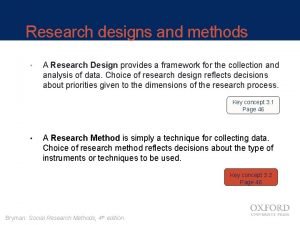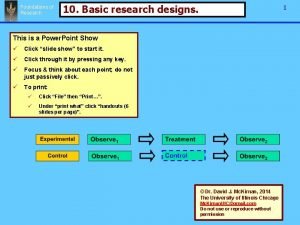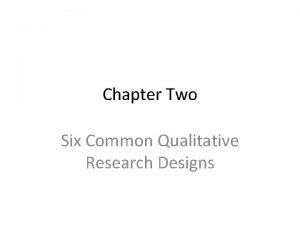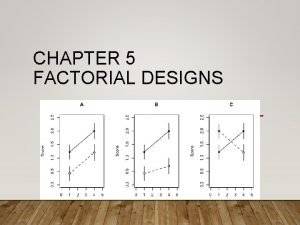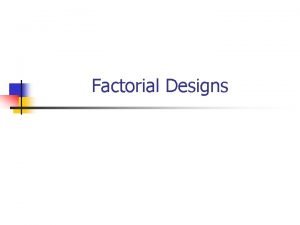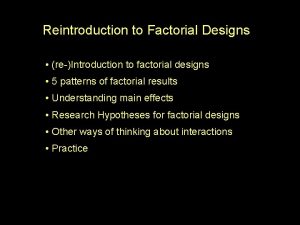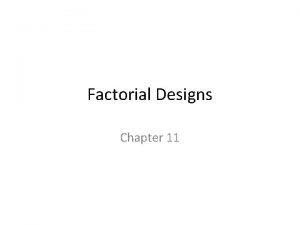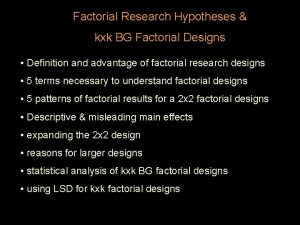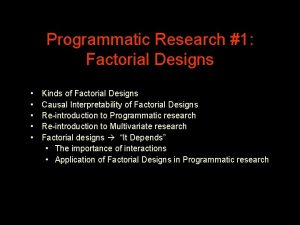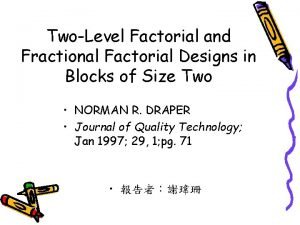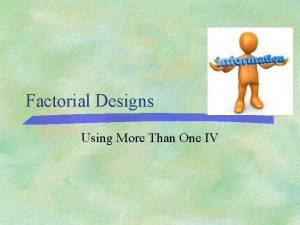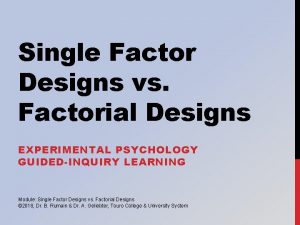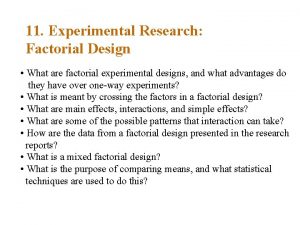Factorial Designs Factorial design a research design that


















- Slides: 18

Factorial Designs Factorial design: a research design that includes two or more factors (Independent Variables) A two-factor design has two IVs. Example: Stress type (relational vs acad) and Coping (emotional vs pragmatic); on academic perf (DV) A single-factor design has one IV Example: acad perf Stress type (relational vs acad) on

Structure of a Two-Factor Experiment On Paper Computer Time Limit Exam scores for a group of participants who studied text presented on paper for a fixed time. Exam scores for a group of participants who studied text presented on screen for a fixed time. No Time limit Exam scores for a group of participants who studied text presented on paper for a self-regulated time. Exam scores for a group of participants who studied text presented on screen for a self-regulated time. The levels of one factor determine the columns and the levels of the second factor determine the rows. Copyright © 2019 Cengage. All rights reserved.

Independence of Main Effects and Interactions The two-factor study allows researchers to evaluate three separate sets of mean differences: The mean differences from the main effect of factor A The mean differences from the main effect of factor B The mean differences from the interaction between factors

Main Effects • The main effect is the mean differences among the levels of one factor. − A two-factor study has two main effects; one for each factor. The data are structured to create main effects for both factors but no interaction. On Paper On Computer Time Limit M = 22 M = 18 Overall M = 20 No Time Limit M = 18 M = 14 Overall M = 16 Overall M = 20 Overall M = 16 Copyright © 2019 Cengage. All rights reserved.

A Line Graph Indicating No Interaction Copyright © 2019 Cengage. All rights reserved.

Interaction Between Factors The data are structured to create the same main effects, but the cell means have been adjusted to produce an interaction. On Paper Computer Time Limit M = 20 Overall M = 20 No Time Limit M = 20 M = 12 Overall M = 16 Overall M = 20 Overall M = 16 Copyright © 2019 Cengage. All rights reserved.

A Line Graph Indicating Interaction Copyright © 2019 Cengage. All rights reserved.

Interaction Between Factors One factor has a direct influence on the effect of a second factor. The effect of one factor depends on the levels of another factor Can Analyze if Main Factor effects varies based on: Mediating Variables Moderating Variables No Treatment Control Placebo Group

Factorial Example: Pretest–Posttest Control Group Design Pretest Posttest Treatment Group Pretest scores for Posttest scores for participants who receive the treatment Control Group Pretest scores for participants who do not receive the treatment Posttest scores for participants who do no receive the treatment Copyright © 2019 Cengage. All rights reserved.

Interpreting Main Effects and Interactions Significant effects indicated by a statistical analysis ► be careful about interpreting the outcome. If a Significant Interaction exists, Main Effects are interpreted with caution

Types of Factorial Designs Between-subjects Requires a large number of participants Individual differences can become confounding variables. Avoids order effects Within-subjects Each participant must undergo a high number of treatments. Time consuming and contributed to attrition Also increases risk of carry-over effects Require only one group of participants Eliminates problems with individual differences

Mixed Designs Mixed designs: within- and between-subjects A mixed design: a factorial study that combines two different research designs. Used when one factor is expected to threaten validity A common example of a mixed design is a factorial study with one between-subjects factor and one within-subjects factor. Example: A Placebo group

Quasi-Experimental Research Strategies A factorial study for which all the factors are nonmanipulated, quasi-independent variables. Note: the nonmanipulated variables are still called factors. Example: Having a Demographic Variable serve as a factor (Males vs Females, Levels of SES, etc. )

Combined Strategies Uses two different research strategies in the same factorial design One factor is a true IV (experimental strategy). The second factor is a quasi-independent variable (nonexperimental or quasiexperimental strategy). Falls into one of the following categories: a preexisting participant characteristic or time

Statistical Analysis of Factorial Designs Depends partly on whether the factors are: Between-subjects Within-subjects Some mixture of between- and within-subjects The standard practice includes: Computing the mean for each treatment condition (cell) and Using ANOVA to evaluate the statistical significance of the mean differences

Applications of Factorial Designs Expanding and replicating a previous study Replication: repeating the previous study by using the same factor or IV exactly as it was used in the earlier study Expansion: adding a second factor in the form of new conditions or new participant characteristics Ascertain whether previously reported effects can be generalized to new situations/new populations

Reducing Variance in Between-Subjects Designs Using a participant variable as a second factor Purpose is to reduce the variance within groups by using the specific variable as a second factor ► creates a twofactor study Greatly reduces individual differences within each group Does not sacrifice external validity

Evaluating Order Effects in Within-Subjects Design Using the Order of Treatments as a Second Factor Makes it possible to evaluate any order effects that exist in the data There are three possible outcomes that can occur: No order effects Symmetrical order effects Nonsymmetrical order effect
 Factorial designs
Factorial designs Disinhibition
Disinhibition Ngoại tâm thu thất chùm đôi
Ngoại tâm thu thất chùm đôi Block xoang nhĩ ecg
Block xoang nhĩ ecg Thơ thất ngôn tứ tuyệt đường luật
Thơ thất ngôn tứ tuyệt đường luật Thơ thất ngôn tứ tuyệt đường luật
Thơ thất ngôn tứ tuyệt đường luật Walmart thất bại ở nhật
Walmart thất bại ở nhật Tìm độ lớn thật của tam giác abc
Tìm độ lớn thật của tam giác abc Hãy nói thật ít để làm được nhiều
Hãy nói thật ít để làm được nhiều Tôn thất thuyết là ai
Tôn thất thuyết là ai Gây tê cơ vuông thắt lưng
Gây tê cơ vuông thắt lưng Sau thất bại ở hồ điển triệt
Sau thất bại ở hồ điển triệt Qualitative paper example
Qualitative paper example Study design types
Study design types Basic research designs
Basic research designs Qualitative research designs chapter 10
Qualitative research designs chapter 10 Types of qualitative design in research
Types of qualitative design in research Types of action research design
Types of action research design Types of empirical research
Types of empirical research













